
Identification Practice for the
Dixon Christmas Bird Count
Species observed in
16
15
14
13
12
11
10
9-8
7-6-5
4-3-2
1
out of 16 years of the count.
This Learning-Feature was developed for the 2013 CBC season. As we prepare for the 2019 season, we now have 22 years of data. (See Updated Compilation)
This feature stresses the most commonly occuring species, so there is little change in the relative frequencies of those species.
A good preparation for the 2019 count is still provided.
An update of this feature will take place at a later date.
English Name:
Genus species: | Comments | Photos |
| Woodpeckers |
Lewis’s Woodpecker
Melanerpes lewis
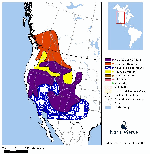
Enlarge Map
External Sites:
Cornell
USGS
Image Search | A distinctive red-bellied, black-backed woodpecker.
White ring on neck and throat usually visible when perched or in flight.
Only woodpecker that "hawks" insects, making looping flights to catch insects before returning to the same perch. | 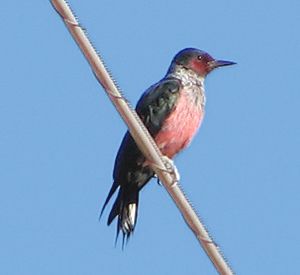
El Bosque |
| Jays, Crows and their Allies |
Pinyon Jay
Gymnorhinus cyanocephalus
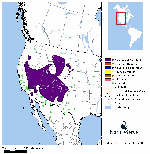
Enlarge Map
External Sites:
Cornell
USGS
Image Search | Usually observed while calling in flight.
Flocks feed in harvested corn fields or on Piñon-Juniper Hillsides
Generally in flocks of 30-70 individuals.
Distinguished from Western Scrub-jay by shorter tail and by flocking behavior. | 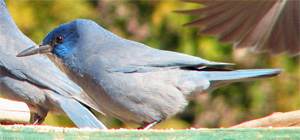
Apodaca
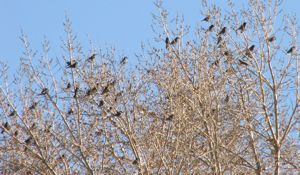
Apodaca
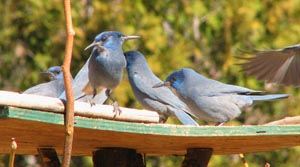
Apodaca |
| Chickadees and their Allies |
Bushtit
Psaltriparus minimus
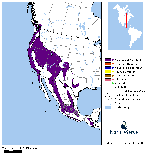
Enlarge Map
External Sites:
Cornell
USGS
Image Search | Tiny (~4in) plain gray bird.
Usually travels in groups of 10-20 individuals, constantly moving from bush to bush feeding.
Flocking birds constantly make varied twittering sounds. | 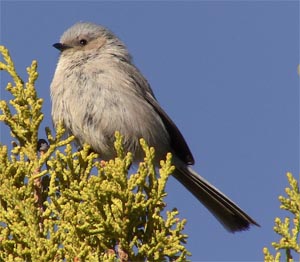
Camino Lejo, Santa Fe |
| Thrushes and their Allies |
Western Bluebird
Sialia mexicana
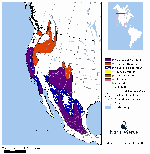
Enlarge Map
External Sites:
Cornell
USGS
Image Search | Male (top photo) has blue head and red breast.
During breeding season, colors more intense than shown here.
Female (lower photo) has blue in wings, but appears gray from front with a light buffy breast.
Note white eye-ring. | 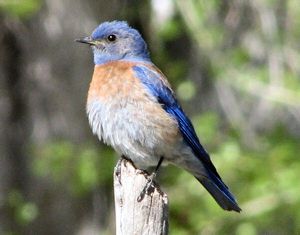
El Bosque
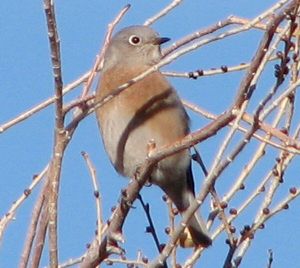
El Bosque |
| Towhees |
Spotted Towhee
Pipilo maculatus
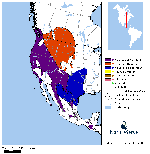
Enlarge Map
External Sites:
Cornell
USGS
Image Search | One is seldom far from a Spotted Towhee. But though they are nearby, they are usually hidden away under trees and shrubs where they toss leaves with their feet looking for insects to eat.
Occasionally you will see one at the edge of the road or briefly flying from one shrub to the next.
However, they regularly produce a contact call, a low growl.
Hear Contact Call
If you listen for that call and follow it, may be rewarded with a view of this lovely bird with a red eye.
Note white breast with rufous (reddish) flanks.
Lower Photo shows bird in its preferred habitat. | 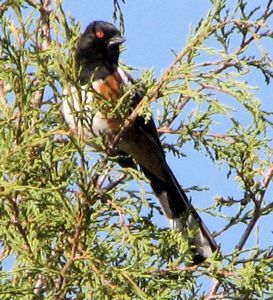
Arroyo la Mina
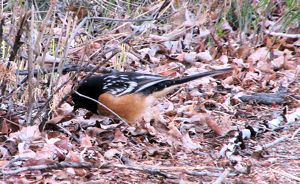
El Bosque Enlarge |














